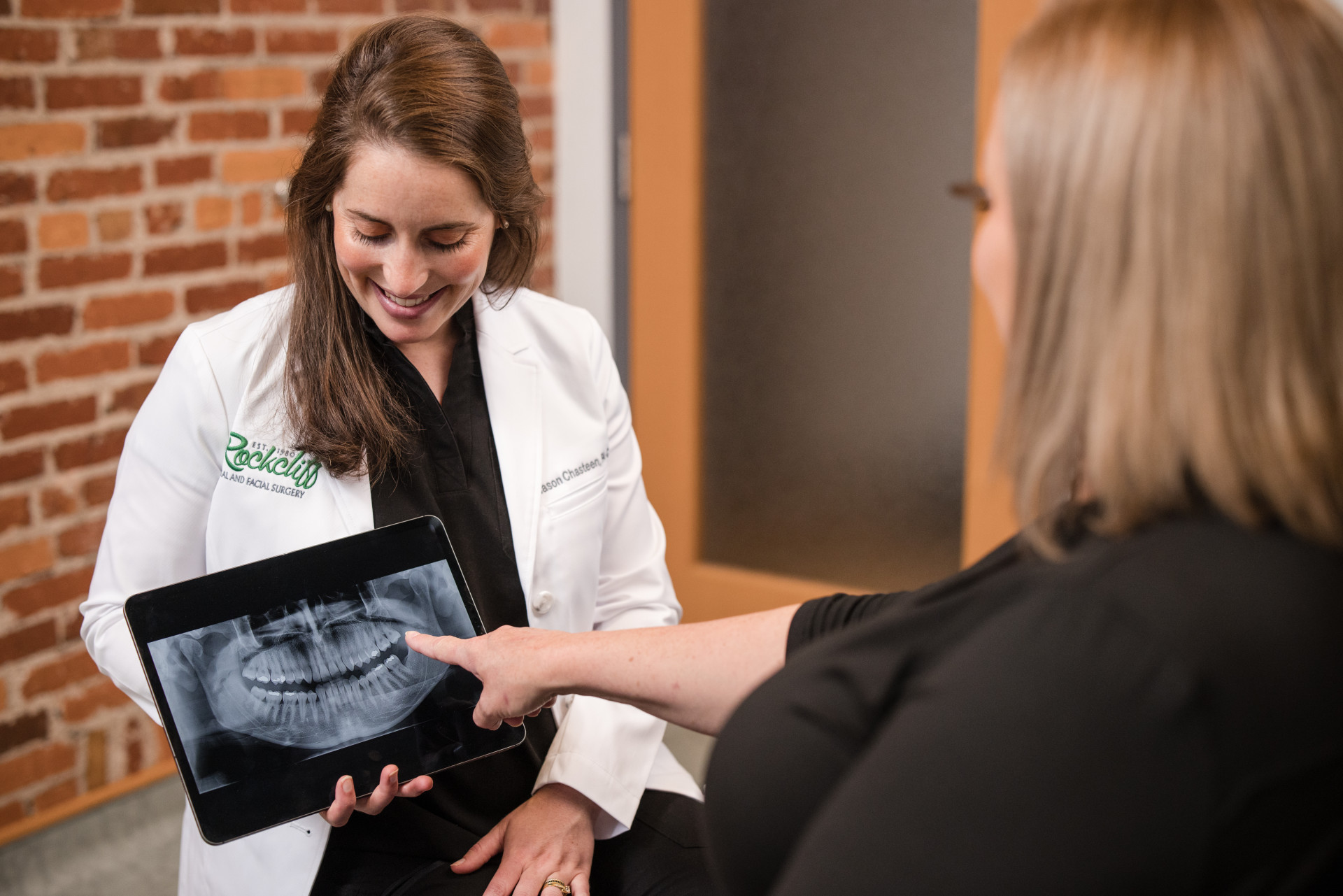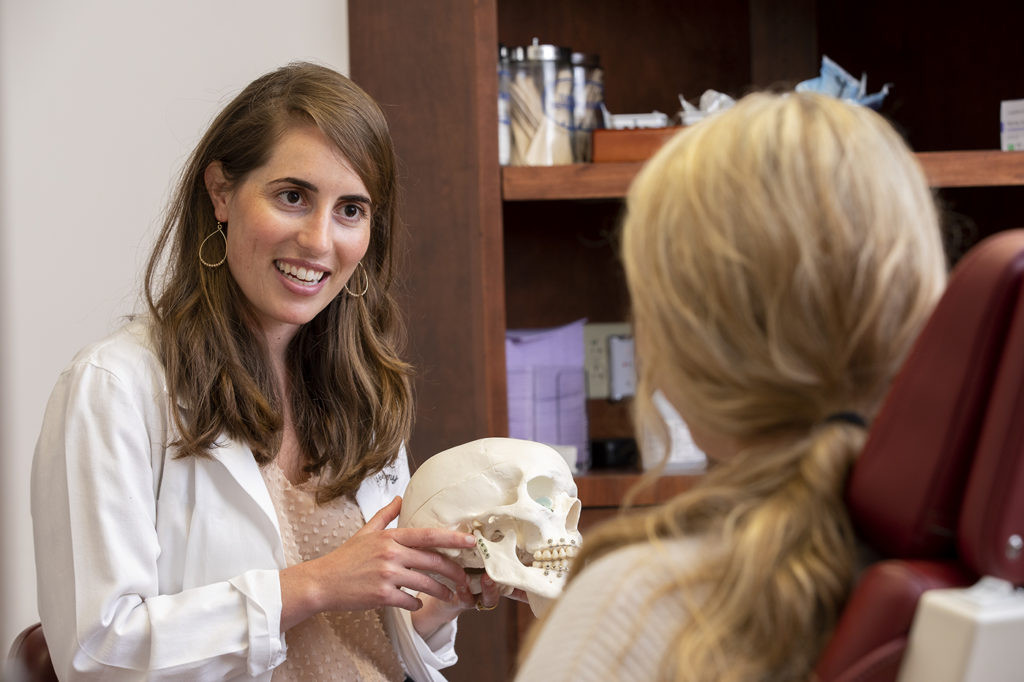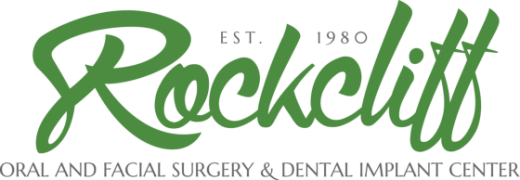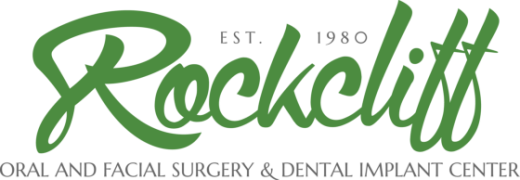How are jaw joint and muscle problems treated?
Determining the source of your jaw joint and muscle symptoms requires careful evaluation. At your initial consultation our providers will get to know you, understand your concerns, and determine how to best achieve your goals for treatment. You should expect to discuss your medical history, any medications you take, and undergo a brief health review. Your provider will perform a physical exam and obtain any necessary x-rays. We take time to help you understand your condition, any necessary treatment, and answer any questions you may have.
We emphasize a team approach with patients with jaw joint and muscle problems. Our providers work closely with local physical therapists, dentists, physicians, chronic pain specialists, and psychiatrists to provide a treatment plan specific to your needs and ensure the best possible outcome.
Treatment of your jaw joint and muscle symptoms can take time. No single treatment will work for every patient. Our providers will strive to find the right treatment for your particular needs.
Nonsurgical Treatment
Around 70% of patients with jaw joint disease can be managed successfully without surgery. Nonsurgical therapies can help reduce symptoms, limit further joint damage, and improve diet and quality of life.
Treatments can include:
Self-care, including:
- A soft diet. Avoid hard, chewing, sticky foods. No chewing gum, ice, or nuts.
- Stress reduction and changes in behavior
- Jaw muscle and neck stretches
- Moist heat or cold packs to the jaw
Medications, including:
- Anti-inflammatory pain medications
- Muscle relaxants
Bite splint therapy
Bite splint therapy can greatly help patients who grind or clench their teeth. A small plastic mouth guard is custom-made to fit over your upper teeth at night. Bite splint therapy will help support the jaw, reduce stress on the joints, and protects your teeth from damage that occurs when grinding.
Physical therapy
Physical therapists can help improve neck posture, strengthen jaw muscles, and improve range of motion. Treatments may include manual therapy, jaw exercises, therapeutic ultrasound, dry needling, or low-level laser therapy.
Botulinum muscle injections (Botox®)
Botox® is a medication that when injected into the jaw muscles causes relaxation – helping reduce pain, muscle spasms, or tightness.
Surgical Treatment
A small number of patients may eventually require surgery. Most surgical treatments are minimally invasive and are completed in the office or at Mission Hospital under anesthesia.
Arthrocentesis and Arthroscopy
Arthrocentesis is a minimally invasive procedure to improve joint mobility and reduce inflammation. Two hypodermic needles are placed into the joint allowing for the joint to be washed. This helps remove inflammatory debris and any adhesions that limit normal movement of the joint. Arthroscopy uses a camera to be able to visualize conditions inside the joint after the joint is washed.
Arthrocentesis is usually considered in patients with a sudden, severe restriction in mouth opening or for degenerative inflammatory conditions of the joint that are not responding to nonsurgical therapies.
Intraoral vertical ramus osteotomy
Intraoral vertical ramus osteotomy is a procedure to help reposition the lower jaw into a more natural position within the joint. This creates additional space within the joint – improving movement of the meniscus and reducing joint pain and sounds.
Open Joint Surgery
Open joint surgery is rare and is typically reserved for patients with limited mouth opening, joint dislocation, or significant degeneration of the joint.
An Oral Surgeon's Overview of TMJ Disorder
Temporomandibular joint (TMJ) disorder is a multifaceted medical condition that intricately affects the joint connecting the jawbone to the skull, resulting in an array of distressing symptoms for individuals. Specializing in oral and facial healthcare, Rockliff stands out as a leading institution in the management of TMJ disorders. Patients seeking diagnosis at this renowned center undergo a comprehensive evaluation, which includes thorough physical examinations and advanced imaging studies overseen by expert Oral and Maxillofacial Surgeons (OMS) and Physician Assistants (PA). By integrating expertise across multiple disciplines, these institutions and Doctors ensure a precise and thorough assessment of TMJ symptoms such as jaw pain, chewing difficulties, joint noises, and limited mobility. With a patient-centric approach, Rockliff prioritize sindividualized care, offering effective treatment strategies tailored to each patient's unique needs for optimal management of TMJ concerns.
Oral and Maxillofacial Surgeons (OMS) are dental specialists who have undergone extensive training in both dentistry and medicine, allowing them to provide comprehensive care to patients with complex and multifaceted issues affecting the face and oral cavity. Dr. Warren, an experienced Oral and Maxillofacial Surgeon, is a respected expert in TMJ disorders and facial trauma. With his expertise in surgery, he is well-equipped to manage complex cases that require surgical intervention. Physician Assistants (PA), on the other hand, are highly trained medical professionals who work alongside OMSs to provide patient care, often serving as a vital extension of the medical team. Mason Chasteen, a Physician Assistant with extensive training in TMJ disorders and facial trauma provides comprehensive care to patients. As a PA, Mason works closely with Dr. Warren, and other OMSs, to evaluate patients, diagnose conditions, and develop treatment plans. As a PA, Mason was brought on board to alleviate the TMJ waitlist at Rockliff that was previously 6 month-2 year wait, by providing non-surgical treatment options to patients with TMJ disorders. This approach allows patients to receive timely and effective care without the need for surgery. Mason's scope of practice includes evaluating and managing pre-operative and post-operative patients, thereby facilitating the surgeon's ability to see patients more quickly and treat them more efficiently.
TMJ disorders can be classified into acute and chronic conditions, each with unique characteristics and treatment plans. Acute TMJ usually involves sudden onset of symptoms such as jaw pain, clicking or popping sounds, and limited jaw movement, often resulting from trauma, bruxism, or stress. “A lot of what I’ll see are patients that are having an acute exasperation of their TMJ problems. Those are people that are in intense pain that comes out of nowhere or builds up,” (Chasteen). However, chronic TMJ is characterized by persistent or recurrent symptoms lasting over three months, which may be accompanied by headaches, ear pain, and muscle stiffness. Chasteen mentions that chronic pain is characterized more by someone who has “arthritic joints, chronic grinder and clencher” and someone who has “dull pain but is manageable.” Treatment approaches for acute TMJ focus on managing pain and inflammation through rest, heat or ice therapy, and pain medications. In contrast, chronic TMJ requires a more comprehensive treatment plan involving lifestyle modifications, stress management techniques, physical therapy, and possibly dental interventions or surgery if conservative measures are ineffective. By understanding the differences between acute and chronic TMJ, healthcare professionals can tailor treatment strategies to effectively address the specific needs of each individual patient.

As a specialist in the diagnosis and treatment of Temporomandibular Joint (TMJ) disorders, Dr. Warren employs a multi-faceted approach to accurately diagnose and treat patients with TMJ issues. This involves a thorough clinical examination, combined with advanced imaging techniques, to provide a comprehensive understanding of the underlying causes of the patient's symptoms. This tailored approach goes beyond surface-level remedies, allowing Dr. Warren to develop a personalized treatment plan that addresses the unique needs and concerns of each patient. “If they’re having diffuse muscle pain, what’s called maxillofacial pain, then typically treatment for that is non-surgical. But for folks that have more joint specific problems, articular problems, then I tend to start with non-surgical treatment as well, just because a vast majority do show improvement” (Dr. Warren, OMS). This nuanced approach incorporates a range of interventions, including lifestyle modifications, stress reduction techniques, and dietary advice, as well as targeted physical therapy and custom dental appliances. In some cases, surgical interventions may be necessary to achieve optimal results. By taking a holistic approach, Rockliff provides sustained relief and improved quality of life for individuals grappling with TMJ disorders, showing their commitment to patient-centered care and wellness.
Non-surgical treatments can provide significant relief from symptoms and improve overall jaw function. These treatments focus on addressing the underlying causes of TMJ disorders, including stress, anxiety, and muscle tension. Self-care measures, such as using ice and heat, practicing relaxation techniques, and avoiding certain activities that can exacerbate symptoms, are essential components of a comprehensive treatment plan. Medications, including pain relievers and muscle relaxants, can help alleviate discomfort and reduce inflammation in the jaw joint. Physical therapy is another valuable non-surgical treatment option for TMJ. It involves stretching and strengthening exercises to improve jaw mobility and reduce muscle tension. By working with a skilled physical therapist, patients can learn techniques to relax their jaw muscles, correct their posture, and enhance their overall oral health. Oral appliances, such as splints or mouthguards, can also be beneficial in managing TMJ symptoms. These custom-fitted devices help align the jaw properly, prevent teeth grinding, and reduce pressure on the temporomandibular joint.
"Oral and Maxillofacial Surgeons are very, if not the most, qualified to administer Botox. This is an area that we deal with every day." - Dr. Warren, OMS
Botox injections have also shown great results in managing TMJ-related muscle tension and pain. By targeting specific muscles responsible for clenching and grinding, Botox can help reduce muscle contraction, alleviate joint pressure, and protect teeth from further damage. “Oral and Maxillofacial Surgeons are very, if not the most, qualified to administer Botox. This is an area that we deal with every day. It’s an area that we are very capable of diagnosing and treating, as far as TMJ disorders. Typically it requires a little greater of a dose to these muscles, just because they are larger muscles, that some other providers may not feel comfortable administering” (Dr. Warren, OMS). It takes about 3 days to begin having an effect, with up to a maximum effect at 3 weeks, and usually begins to wear off after 4 months.
These non-surgical treatments not only alleviate symptoms but also promote healing and proper jaw function. By empowering patients with the tools and resources to address their symptoms effectively, these treatments encourage self-care practices, lifestyle modifications, and active participation in their treatment plan. Ultimately, a comprehensive non-surgical approach to managing TMJ disorders can help patients take control of their symptoms, improve their overall quality of life, and prevent further complications related to the disorder.
For individuals with TMJ disorders that are not responding to non-surgical treatments, surgery may be a viable option. Arthroscopy is a minimally invasive procedure that allows healthcare providers to directly visualize the internal structures of the TMJ and address any issues causing pain or dysfunction. This technique involves creating a small incision and inserting miniature cameras to identify and repair damaged tissues, remove adhesions, or reposition displaced cartilage within the joint. Arthrocentesis is another less invasive surgical option that involves flushing the joint with sterile fluid to remove debris, inflammatory byproducts, and metabolic waste that may be contributing to discomfort and limited mobility. This technique is often performed in an outpatient setting and requires minimal downtime, making it a convenient option for individuals seeking immediate relief from their TMJ symptoms.
For individuals with more complex or severe TMJ issues, open joint surgery may be recommended to address underlying structural abnormalities and restore optimal jaw function. This type of surgery typically involves more extensive procedures, such as joint disc repairs, joint reconstructions, or in severe cases, total joint replacements. Total joint replacement is considered a last resort for individuals with irreversible TMJ damage that has not responded to other treatments. During this procedure, the damaged joint is replaced with artificial components made of materials like metal, ceramic, or plastic. This surgery can alleviate pain, restore jaw function, and enhance overall quality of life for individuals with severe TMJ degeneration.
When considering surgical treatments for TMJ, it is crucial to consult with a knowledgeable healthcare provider who specializes in TMJ disorders and has experience with various surgical techniques. A thorough evaluation, including diagnostic tests, imaging studies, and a detailed medical history, will help determine the most appropriate surgical approach for your specific needs and condition. Patients undergoing TMJ surgery can expect personalized care and post-operative education to guide them through the recovery process. Healthcare providers prioritize patient education on post-operative care, including range of motion exercises, proper joint protection, and strategies to manage and minimize parafunctional habits like teeth clenching. Following surgery, patients are monitored closely to ensure successful healing and functional recovery, with the goal of helping individuals return to their normal lives without the burden of TMJ symptoms.
After undergoing surgery for TMJ disorder, patients are at risk of experiencing a recurrence of symptoms if they do not modify their habitual behaviors. Teeth grinding, clenching, nail-biting, and excessive gum chewing can lead to muscle fatigue, inflammation, and structural misalignment, which can exacerbate existing TMJ pain and impede treatment efficacy. Additionally, poor posture practices can contribute to increased tension and compromised jaw function, intensifying TMJ symptoms. To prevent a recurrence of symptoms, patients must adopt healthy habits that promote proper jaw function and reduce stress on the joint. This includes avoiding repetitive and excessive pressure on the jaw joint and correcting poor posture practices. By making these changes, patients can reduce the risk of developing chronic TMJ pain and discomfort. In addition to modifying habits, patients should also be aware of the potential consequences of ignoring these habits. Failure to address habitual behaviors can lead to a recurrence of TMJ symptoms, even after surgery. This can result in a cycle of dysfunction and discomfort, making it more challenging to manage symptoms and achieve optimal jaw function.
By understanding the importance of modifying habitual behaviors and practicing healthy habits, patients can take a proactive approach to managing their TMJ disorder and preventing a recurrence of symptoms.
"I can’t tell you how many patients just can do simple things like go to physical therapy or wear a nightguard and it takes away their pain, or it makes their pain really minimal" - Mason Chasteen, PA
Timely identification and intervention for temporomandibular joint disorder symptoms are crucial to prevent potentially catastrophic consequences that can lead to the deterioration and, in some cases, irreversible damage of the jaw joint. When individuals experiencing persistent jaw pain, clicking or popping sounds, restricted jaw movement, and muscle stiffness delay seeking medical attention, the progression of TMJ disorder can result in worsening symptoms and significant repercussions. Untreated TMJ disorder can lead to the deterioration of the joint structure, causing chronic pain, difficulty in chewing, and compromised oral function. As the condition advances, the misalignment and dysfunction of the jaw joint can escalate into severe complications such as persistent headaches, neck pain, and dental issues. Additionally, the prolonged strain on the jaw muscles and joints due to untreated TMJ disorder can trigger secondary health problems, including increased stress levels, sleep disturbances, and decreased quality of life. “I can’t tell you how many patients just can do simple things like go to physical therapy or wear a nightguard and it takes away their pain, or it makes their pain really minimal, where they’ll just have occasional flares. Then they’ll have an understanding of what’s going on and they can avoid certain pain triggers, and they’ll understand where their pain is coming from” (Chasteen, PA). By addressing TMJ symptoms promptly and seeking professional care at the onset of any signs of dysfunction, individuals can prevent the detrimental consequences of delayed treatment, preserve their oral health, and improve their overall well-being. It is essential to recognize the urgency of early intervention to mitigate the risks associated with untreated TMJ disorder and safeguard against the potential long-term consequences of joint deterioration and severe complications.
Dr. Warren highlights the satisfaction of treating patients with acute TMJ disorder, where a simple procedure can bring immediate relief from pain and symptoms. He takes pride in being able to provide a quick and effective solution that improves his patients' quality of life. Dr. Chasteen shares her own experience, noting that she finds it fulfilling to accompany patients on their journey from initial consultation to post-operative care. She enjoys guiding them through the treatment process, explaining their options and answering their questions, and then being there to support them as they recover from surgery. For both Dr. Warren and Dr. Chasteen, the reward of helping patients with TMJ Disorder lies in the positive impact they can have on someone's life. By providing effective treatment and care, they empower their patients to regain control over their health and well-being, and that is truly fulfilling. “TMJ issues can be overcome with proper diagnosis and treatment. It’s something we want to keep track with just to make sure symptoms are not getting worse and that patients can go on to lead more normal lives before treatment” (Dr. Warren, OMS).
By combining the expertise of OMSs and PAs, the Rockliff team can address the complex and multifaceted nature of TMJ disorders, tailoring treatment plans to meet each patient's unique needs. The team is dedicated to providing personalized care that not only alleviates symptoms but also enhances overall quality of life and well-being.
At Rockliff, a multidisciplinary approach to care is prioritized, ensuring seamless coordination between specialists to maximize treatment outcomes. By partnering with the Rockliff’s skilled and empathetic healthcare team, individuals facing TMJ challenges can embark on their treatment journey with confidence, knowing they are receiving comprehensive care that addresses the physical and emotional aspects of their condition.







